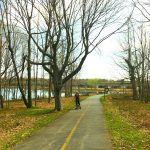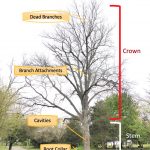Trees provide many benefits for our homes and properties. If a tree is found to have a defect such as dead branches or broken limbs from a storm; it can become a risk issue. It is important to understand that tree owners have a duty to inspect and maintain their trees. All property owners should take reasonable steps to protect themselves by involving a qualified consultant or certified arborist when needed.
All
trees have some sort of risk involved with it. They are living organisms that are endangered by environmental impacts and pests. However, it is important to create a balance between the risk a tree may pose and the benefits provided by the tree. We don’t want to remove trees unnecessarily, but rather reduce the liability by Identifying, analyzing and evaluating the problem.
Inspect regularly: Trees should be assessed through inspections by a qualified arborist, preferably an International Society of Arboriculture Certified Arborist. It is especially important to inspect trees after major weather events. At a minimum, trees should be carefully checked out every 3-5 years.
Document and maintain records: Every inspection should be recorded and kept on file for future reference. Past evaluations can show how a tree has changed in its health and structure over the years. Also, these written evaluations could minimize liability if a failure occurs and a claim is filed against the tree owner.
Tree Inspections
For a tree to be considered a risk it must be defective and a target that is threatened.
A target is people, property or activities that could be injured, damaged or disrupted by a tree failure. Review everything in the target zone. This should include the area inside a circle around the tree, which is at least as wide as the total tree height.
Read the body language of the tree. Inspect each section of the tree including the crown, branches and root zone to check for signs of failure. These include:
- Dead, diseased, dying or broken branches.
- Thinning or poor canopy health.
- An unstable branching pattern overextended or weakly attached branches, or cracks in the stems.
- Cracks or decayed areas in the main trunk.
- Exposed or decayed roots, heaving of the soil, fungus growth or cracks in the soil around the root plate.
Among the characteristics to consider when conducting tree risk evaluations are:
- Decay, cankers, cracks and other positive indicators of weakness in the roots, stems and branches.
- Canopy size, shape and weight distribution. This is especially true in situations where a tree is exposed to windy conditions, is leaning or has a poor stem-to-canopy ratio.
- Crown architecture. Poor branching and similar characteristics can create high-risk situations in strong winds and other weather conditions.
- Plant health and vigor. This determines how a tree can overcome wounding or pest infestations.
What do you do when a defect is found?
The goal is to reduce the likelihood of failure. Most of the time pruning can improve risk situations. Perhaps cabling and bracing may be an option. Also, plant health care improves the trees condition which can reduce risk… the last option should be removal and that should be an informed decision.
Recurrent inspections to determine tree health and condition are important for sustainable, long-lived tree plantings. The most important factor for any tree owner is know when to contact an ISA Certified Arborist who understands tree risk assessment. They can help with the decision making for the tree if there are concerns about its safety and health.
For more information refer to the publication Tree Risk Management and Trees and Storms at the Purdue Education Store.
Find a certified arborist in your area by going to www.treesaregood.org


